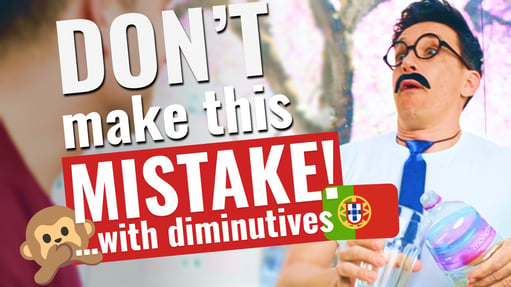Today we’re going to look at diminutives. But what exactly are they?
DiminutivosDiminutives are usually used to describe an object or a person as small or cute. They can also be used to express affection or pity towards someone/ something. Depending on the tone, they can also be used sarcastically.
We often use diminutives when we refer to children, but adults also use them to express love and tenderness, or simply to give a word a “smaller” connotation.
The diminutive is, in fact, one of the three degrees nouns can have. The other two are: normal (the noun itself) and the augmentative.
Although, grammatically, they are exclusive to nouns, in spoken language, diminutives can be used with adjectives as well, which often happens in informal situations.
Diminutives in English
In the English language, the most common diminutives are formed by adding the prefix mini- or by adding suffixes such as –let, -ling, -ette, and –y/-ie.
For example:
- Doggy, mommy, daddy (terms of familiarity and warmth);
- Darling (terms of endearment);
- Booklet, piglet (emphasizing the smallness);
- Miniskirt, minibus (showing that something is smaller or shorter than usual).
Diminutives in Portuguese
In Portuguese, diminutives are used in the same types of context. They play a large role in the Portuguese language by bringing emotion and feeling into words. Almost any noun or adjective can be made “small” by adding the appropriate suffix! That’s why it’s so useful to learn them. Both diminutives and augmentatives can also be employed as an alternative to adverbs such as muitoa lot, very or poucolittle, few .
In contrast, the English diminutives mentioned above are not really true diminutives because English employs them in a more limited and inconsistent way. For example, it wouldn’t be correct to say “breadlet” to refer to a small piece of bread , whereas pãozinho as a diminutive of pãobread would be perfectly fine in Portuguese.
In other words, diminutives are more common and rule-based in Portuguese. So how do we form them?
-inho / -inha
 The most common diminutives are formed by adding the masculine suffix –inho or the feminine suffix –inha. This works for words ending in an unstressed –o or –a.
The most common diminutives are formed by adding the masculine suffix –inho or the feminine suffix –inha. This works for words ending in an unstressed –o or –a.
Replace the -o or -a at the end of the word with –inho or -inha.
Here are some examples:
- gatocat → gatinhokitten, small cute cat
- coitadapoor woman(pitiful sense) → coitadinhapoor little woman (pitiful sense)
Important note: words that end in -co or -ca use the ‘qu’ spelling in order to keep the ‘k’ sound.
- porcopig → porquinholittle pig (and not “porcinho”)
- cascapeel, shell → casquinhasmall peel, small shell (and not “cascinha”)
-zinho / -zinha
 Words that end in a stressed vowels, consonant, or diphthong (2 vowels together) usually add –zinho (masculine suffix) or –zinha (feminine suffix).
Words that end in a stressed vowels, consonant, or diphthong (2 vowels together) usually add –zinho (masculine suffix) or –zinha (feminine suffix).
Add –zinho or -zinha to the end of the word.
For example:
- irmãsister → irmãzinhalittle sister
- mãohand → mãozinhalittle hand
- dorpain → dorzinhaminor pain
- paustick → pauzinholittle stick
Words that end in -e (not stressed), as well as words with endings in –ia, –oa, –ua, –io also use –zinho/zinha:
- rioriver → riozinhosmall river
- praiabeach → praiazinhasmall beach
- estátuastatue → estátuazinhasmall statue
With words that end in –m, you have to replace the ‘m’ with ‘n’ before adding –zinho/zinha:
Important: nouns that don’t change with gender (invariable), do change in the diminutive, and practically all of them use the –zinho/zinha suffix. If you’re also using the plural, and the group has people of both genders, then the masculine is used.
- piratapirate → piratazinholittle pirate (male) & piratazinhalittle pirate (female)
- atletaathlete → atletazinhosmall athlete (male) & atletazinhasmall athlete (female)
When To Use Diminutives
 So, in which contexts do we use diminutives?
So, in which contexts do we use diminutives?
To emphasize small size:
- pãoloaf of bread → pãozinhoroll, small piece of bread
- casahouse → casinhasmall house
- uma cervejaa beer → uma cervejinhaa small beer
To show affection or pity:
- meu anjomy angel → meu anjinhomy little angel
- a minha mãemy mother → a minha mãezinhamy dear mother
- coitadopoor thing → coitadinhopoor little thing
To lessen the importance of something:
- Ele tem uma gripezinhaHe has a little flu
- Tenho uma dorzinha de cabeçaI have a minor headache
- É um hotelzinho feioIt’s an ugly little hotel
To be sarcastic:
- Nós temos um probleminha...We have a little problem... (implying it's actually a huge problem)
- És tão engraçadinha!You're so funny! (female, sing.)
Nicknames:
The diminutive also works for people’s names:
These often become nicknames, showing a degree of love and affection for the person. ❤️
For General Emphasis
 There are certain situations in which the diminutive can be used to emphasize words rather than lessen or downplay them. Words such as tudinho – from tudoeverything – and nadinha– from nadanothing – are two examples.
There are certain situations in which the diminutive can be used to emphasize words rather than lessen or downplay them. Words such as tudinho – from tudoeverything – and nadinha– from nadanothing – are two examples.
If someone says Vais comer tudinhoYou'll eat everything what they imply is “you will eat absolutely everything”. Likewise, if a person says Não vou fazer nadinha hojeI'll be doing nothing today , they mean something like “I will be as lazy as humanly possible”.
The same is true for the word fartinho. Instead of saying Estou muito farto de ficar em casaI'm really tired of being at home , we can use the diminutive (and not augmentative) to say Estou fartinho de estar em casaI'm really tired of being at home . Despite being a diminutive, this means that fartinho actually has a “bigger” meaning than farto.
When NOT to Use Diminutives
 Well, it’s not easy as a non-native speaker, because there aren’t any set rules. But let’s just say that diminutives don’t always mean what you think they’re going to mean! It takes time and exposure to the language to get comfortable with the different uses.
Well, it’s not easy as a non-native speaker, because there aren’t any set rules. But let’s just say that diminutives don’t always mean what you think they’re going to mean! It takes time and exposure to the language to get comfortable with the different uses.
Check out this video to see what we mean! 🙈 Don’t Make This Mistake With Diminutives!
Alternative Diminutives
Many words can have two different diminutives: one that follows the ‘rules’ we’ve shown and other that’s formed by adding an alternative, less common suffix. Other words, however, have just one diminutive that uses one of those alternative suffixes. Some of these diminutives eventually became actual nouns (i.e. with a place in the dictionary) while retaining the same meaning as “small word”. Some of them are:
diabodevil → diabretelittle devil
pequenosmall → pequenitoreally small
bandeiraflag → bandeirolasmall flag
bocamouth → boquitatiny mouth
casahouse → casitasmall house
estátuastatue → estatuetasmall statue
→ livretesmall book
ruastreet → ruelalittle street
rioriver → riachosmall river
We use diminutives in Portuguese because they sound friendly, gentle, and informal. Learning how to use them can feel quite awkward at first, but with some practice, you will be able to use them frequently in your speaking. Later, we’ll learn about their opposites: augmentatives!






Very in-depth, well explained, but a bit overwhelming for a total beginner.
Sorry for the overwhelm — I wouldn’t recommend this one for a complete beginner. This is a more advanced concept that probably wouldn’t be taught until probably the B2 level. It’s good to at least be familiar with, though, so it’s good that you got a preview. Now you can go back to it much later and have a bit more context. 🙂
muito obrigado amiguinhos
Very informative!! I like it a lot
Brilliant! I’ll never remember them all but will now be very aware of them when I read
I accept that there’s no one good sequence in which to learn elements of Portuguese. Even so, I’d appreciate guidance as to what to learn next as some lessons are much more difficult than others, leaving me floundering.
Hi Penny, so sorry for the confusion! When in doubt, we recommend working through the Units from the top to the bottom of the list. They are in order from A1 level content, up to B2 level. This is the best way to “make a path” through the site, starting from the basics and gradually working your way up. Then you can dip into other parts of the site when there is a particular topic you want to explore more.
For example, when you want to do more listening practice, the episodes can be filtered by level. These are the easier Shorties, for example:
Beginner (A1)
Upper Beginner (A2)
You can also use the Site Index here if you are looking for content on a particular topic.
i heard you had a small funny movizino which my friend saw in the plane….is that correct, where is it, it was in a restaurant with Rui with a moustanshe…..
Here is is! 👨🏻 Don’t Make This Mistake With Diminutives!
Hi there,
I’ve learnt that in words such as escola, escrever, escritório we don’t pronounce E at the beginning. In the example of the word estátua and estátuasinha when you listen to the lady’s pronouncing it, she makes a clear E at the beginning of the word. Could you please explain why this word is different?
Many thanks,
Olena
Olá! In regular speech, the starting E is indeed mostly mute, but when pronouncing the words slowly and isolated as in these audio examples, the E may be articulated (in any word, not just this one) if all the syllables are emphasized.
Good explanation and well presented